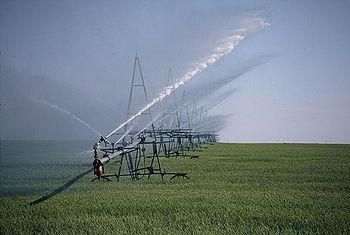
Agricultural News
Study Quantifies Aquifer Depeletion in California and Plains States
Wed, 06 Jun 2012 13:49:11 CDT

A new study looking at aquifer overexploitation in the High Plains and California Central Valley suggests that unsustainable withdrawal in key farming regions will significantly impact crop production in the United States.
Between 1950 and 2007, 4% of the land area in the High Plains, concentrated in Kansas and Texas, was responsible for one third of the Ogallala aquifer depletion, according to the study published in the Proceedings of the National Academy of Sciences last week. The researchers estimate that if consumption patterns from the last decade continue, the aquifer will be unable to support irrigation for nearly 35% of the southern High Plains region within 30 years, due to the low rate of groundwater recharge.
To date, about eight percent of the groundwater in the Ogallala has been depleted, the study says.
The rate of depletion varies greatly from the northern High Plains to the southern. In Nebraska, water levels have fallen less than one meter between 1950 and 2007. In portions of Kansas, Texas and the Oklahoma panhandle, water levels have dropped more than 30 meters.
Even though water levels have remained high in the northern regions of the Ogallala, the study says discharge from the aquifer into rivers and streams has diminished by 50 percent.
A newly developed High Plains recharge map shows that high recharge in the northern High Plains results in sustainable pumpage, whereas lower recharge in the central and southern High Plains has resulted in focused depletion of fossil groundwater, mostly collected during the past 13,000 years.
The study predicts that farmers in the southern High Plains most affected by the decreasing levels in the aquifer will need to return to non-irrigated, dry land crops such as cotton instead of corn.
You can find the complete study by clicking here.
WebReadyTM Powered by WireReady® NSI
Top Agricultural News
More Headlines...




















